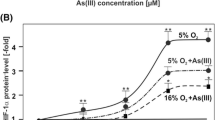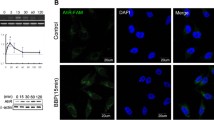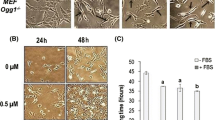Abstract
Chronic arsenic exposure causes cancers in multiple organs in humans. However, the mechanisms underlying arsenic-induced carcinogenesis remain obscure. Here, we examined whether chronic arsenite (As(III)) exposure promotes cell migration induced by heparin-binding EGF-like growth factor (HB-EGF) in human esophageal immortalized Het1A cells. When Het1A cells were exposed to 0.5 μM As(III) for 4 months, HB-EGF-induced migration was enhanced in As(III)-exposed Het1A cells compared to controls. To elucidate the mechanisms underlying the promotion of HB-EGF-induced migration by chronic exposure to As(III), we compared ERK phosphorylation between As(III)-exposed and control Het1A cells and found that HB-EGF-induced ERK phosphorylation was enhanced in the As(III)-exposed cells. We next measured mRNA levels of 88 genes related to cell cycle regulation. The results showed elevated cyclin D1 mRNA levels in As(III)-exposed Het1A cells. The inhibitors of ERK and cyclin D/Cdk4 markedly suppressed HB-EGF-induced upregulation of cyclin D1 and the migration of Het1A cells, respectively, suggesting that cyclin D1 is located downstream of ERK and is required for HB-EGF-induced migration of Het1A cells. Collectively, these findings indicate that the promotion of HB-EGF-induced migration of Het1A cells chronically exposed to submicromolar As(III) might be caused by increased expression of cyclin D1 mediated by enhanced activation of the ERK pathway.










Similar content being viewed by others
References
Andrew AS, Mason RA, Memoli V, Duell EJ (2009) Arsenic activates EGFR pathway signaling in the lung. Toxicol Sci 109(2):350–357. https://doi.org/10.1093/toxsci/kfp015
Barrett JC, Lamb PW, Wang TC, Lee TC (1989) Mechanisms of arsenic-induced cell transformation. Biol Trace Elem Res 21:421–429
Chen Y, Ahsan H (2004) Cancer burden from arsenic in drinking water in Bangladesh. Am J Public Health 94(5):741–744
Choi YJ, Anders L (2014) Signaling through cyclin D-dependent kinases. Oncogene 33(15):1890–1903. https://doi.org/10.1038/onc.2013.137
Cooper KL, King BS, Sandoval MM, Liu KJ, Hudson LG (2013) Reduction of arsenite-enhanced ultraviolet radiation-induced DNA damage by supplemental zinc. Toxicol Appl Pharmacol 269(2):81–88. https://doi.org/10.1016/j.taap.2013.03.008
Ding W, Liu W, Cooper KL et al (2009) Inhibition of poly(ADP-ribose) polymerase-1 by arsenite interferes with repair of oxidative DNA damage. J Biol Chem 284(11):6809–6817. https://doi.org/10.1074/jbc.M805566200
Engel RR, Hopenhayn-Rich C, Receveur O, Smith AH (1994) Vascular effects of chronic arsenic exposure: a review. Epidemiol Rev 16(2):184–209
Faull RJ, Stanley JM, Fraser S, Power DA, Leavesley DI (2001) HB-EGF is produced in the peritoneal cavity and enhances mesothelial cell adhesion and migration. Kidney Int 59(2):614–624. https://doi.org/10.1046/j.1523-1755.2001.059002614.x
Feng T, Xu D, Tu C et al (2015) MiR-124 inhibits cell proliferation in breast cancer through downregulation of CDK4. Tumour Biol 36(8):5987–5997. https://doi.org/10.1007/s13277-015-3275-8
Feng T, Xu J, He P, Chen Y, Fang R, Shao X (2017) Decrease in stathmin expression by arsenic trioxide inhibits the proliferation and invasion of osteosarcoma cells via the MAPK signal pathway. Oncol Lett 14(2):1333–1340. https://doi.org/10.3892/ol.2017.6347
Godin JD, Nguyen L (2014) Novel functions of core cell cycle regulators in neuronal migration. Adv Exp Med Biol 800:59–74. https://doi.org/10.1007/978-94-007-7687-6_4
Hasibuzzaman MM, Hossain S, Islam MS et al (2017) Association between arsenic exposure and soluble thrombomodulin: a cross sectional study in Bangladesh. PLoS One 12(4):e0175154. https://doi.org/10.1371/journal.pone.0175154
Higashiyama S, Nanba D (2005) ADAM-mediated ectodomain shedding of HB-EGF in receptor cross-talk. Biochim Biophys Acta 1751(1):110–117. https://doi.org/10.1016/j.bbapap.2004.11.009
Hossain K, Hasibuzzaman MM, Himeno S (2019) Characteristics and health effects of arsenic exposure in Bangladesh. In: Yamauchi H, Sun G (ed) Arsenic contamination in Asia, Springer, Singapore, pp 4–60. https://doi.org/10.1007/978-981-13-2565-6_4
Islam MS, Mohanto NC, Karim MR et al (2015) Elevated concentrations of serum matrix metalloproteinase-2 and -9 and their associations with circulating markers of cardiovascular diseases in chronic arsenic-exposed individuals. Environ Health 14:92. https://doi.org/10.1186/s12940-015-0079-7
Kadono T, Inaoka T, Murayama N et al (2002) Skin manifestations of arsenicosis in two villages in Bangladesh. Int J Dermatol 41(12):841–846
Karim MR, Rahman M, Islam K et al (2013) Increases in oxidized low-density lipoprotein and other inflammatory and adhesion molecules with a concomitant decrease in high-density lipoprotein in the individuals exposed to arsenic in Bangladesh. Toxicol Sci 135(1):17–25. https://doi.org/10.1093/toxsci/kft130
Kasai N, Kobayashi K, Shioya S et al (2012) Soluble heparin-binding EGF-like growth factor (HB-EGF) detected by newly developed immuno-PCR method is a clear-cut serological biomarker for ovarian cancer. Am J Transl Res 4(4):415–421
Koivisto L, Jiang G, Hakkinen L, Chan B, Larjava H (2006) HaCaT keratinocyte migration is dependent on epidermal growth factor receptor signaling and glycogen synthase kinase-3alpha. Exp Cell Res 312(15):2791–2805. https://doi.org/10.1016/j.yexcr.2006.05.009
Lee NY, Ray B, How T, Blobe GC (2008) Endoglin promotes transforming growth factor beta-mediated Smad 1/5/8 signaling and inhibits endothelial cell migration through its association with GIPC. J Biol Chem 283(47):32527–32533. https://doi.org/10.1074/jbc.M803059200
Li Z, Jiao X, Wang C et al (2006a) Cyclin D1 induction of cellular migration requires p27(KIP1). Cancer Res 66(20):9986–9994. https://doi.org/10.1158/0008-5472.CAN-06-1596
Li Z, Wang C, Prendergast GC, Pestell RG (2006b) Cyclin D1 functions in cell migration. Cell Cycle 5(21):2440–2442. https://doi.org/10.4161/cc.5.21.3428
Li L, Lu Y, Stemmer PM, Chen F (2015) Filamin A phosphorylation by Akt promotes cell migration in response to arsenic. Oncotarget 6(14):12009–12019. https://doi.org/10.18632/oncotarget.3617
Linke M, Pham HT, Katholnig K et al (2017) Chronic signaling via the metabolic checkpoint kinase mTORC1 induces macrophage granuloma formation and marks sarcoidosis progression. Nat Immunol 18(3):293–302. https://doi.org/10.1038/ni.3655
Mass MJ, Wang L (1997) Arsenic alters cytosine methylation patterns of the promoter of the tumor suppressor gene p53 in human lung cells: a model for a mechanism of carcinogenesis. Mutat Res 386(3):263–277
Miyamoto S, Hirata M, Yamazaki A et al (2004) Heparin-binding EGF-like growth factor is a promising target for ovarian cancer therapy. Cancer Res 64(16):5720–5727. https://doi.org/10.1158/0008-5472.CAN-04-0811
Nabeshima A, Matsumoto Y, Fukushi J et al (2015) Tumour-associated macrophages correlate with poor prognosis in myxoid liposarcoma and promote cell motility and invasion via the HB-EGF-EGFR-PI3K/Akt pathways. Br J Cancer 112(3):547–555. https://doi.org/10.1038/bjc.2014.637
Nguyen L, Besson A, Roberts JM, Guillemot F (2006) Coupling cell cycle exit, neuronal differentiation and migration in cortical neurogenesis. Cell Cycle 5(20):2314–2318. https://doi.org/10.4161/cc.5.20.3381
Ongusaha PP, Kwak JC, Zwible AJ et al (2004) HB-EGF is a potent inducer of tumor growth and angiogenesis. Cancer Res 64(15):5283–5290. https://doi.org/10.1158/0008-5472.CAN-04-0925
Ortega S, Malumbres M, Barbacid M (2002) Cyclin D-dependent kinases, INK4 inhibitors and cancer. Biochim Biophys Acta 1602(1):73–87. https://doi.org/10.1016/s0304-419x(02)00037-9
Pinto BI, Cruz ND, Lujan OR, Propper CR, Kellar RS (2019) In vitro scratch assay to demonstrate effects of arsenic on skin cell migration. J Vis Exp. https://doi.org/10.3791/58838
Postlethwaite AE, Keski-Oja J, Moses HL, Kang AH (1987) Stimulation of the chemotactic migration of human fibroblasts by transforming growth factor beta. J Exp Med 165(1):251–256
Qie S, Diehl JA (2016) Cyclin D1, cancer progression, and opportunities in cancer treatment. J Mol Med (Berl) 94(12):1313–1326. https://doi.org/10.1007/s00109-016-1475-3
Rahman M (2002) Arsenic and contamination of drinking-water in Bangladesh: a public-health perspective. J Health Popul Nutr 20(3):193–197
Rahman FB, Kadowaki Y, Ishihara S et al (2010) Fibroblast-derived HB-EGF promotes Cdx2 expression in esophageal squamous cells. Lab Invest 90(7):1033–1048. https://doi.org/10.1038/labinvest.2010.71
Rossman TG, Stone D, Molina M, Troll W (1980) Absence of arsenite mutagenicity in E coli and Chinese hamster cells. Environ Mutagen 2(3):371–379
Roy RV, Son YO, Pratheeshkumar P et al (2015) Epigenetic targets of arsenic: emphasis on epigenetic modifications during carcinogenesis. J Environ Pathol Toxicol Oncol 34(1):63–84
Sheppard KE, McArthur GA (2013) The cell-cycle regulator CDK4: an emerging therapeutic target in melanoma. Clin Cancer Res 19(19):5320–5328. https://doi.org/10.1158/1078-0432.CCR-13-0259
Squires MS, Nixon PM, Cook SJ (2002) Cell-cycle arrest by PD184352 requires inhibition of extracellular signal-regulated kinases (ERK) 1/2 but not ERK5/BMK1. Biochem J 366(Pt 2):673–680. https://doi.org/10.1042/BJ20020372
Tamura RE, Paccez JD, Duncan KC et al (2016) GADD45alpha and gamma interaction with CDK11p58 regulates SPDEF protein stability and SPDEF-mediated effects on cancer cell migration. Oncotarget 7(12):13865–13879. https://doi.org/10.18632/oncotarget.7355
Tannock I (2005) The basic science of oncology, 4th edn. McGraw-Hill, Medical Pub. Division, New York
Tseng WP, Chu HM, How SW, Fong JM, Lin CS, Yeh S (1968) Prevalence of skin cancer in an endemic area of chronic arsenicism in Taiwan. J Natl Cancer Inst 40(3):453–463
Zhang L, Kim S, Ding W et al (2015) Arsenic sulfide inhibits cell migration and invasion of gastric cancer in vitro and in vivo. Drug Des Devel Ther 9:5579–5590. https://doi.org/10.2147/DDDT.S89805
Zhou Q, Xi S (2018) A review on arsenic carcinogenesis: epidemiology, metabolism, genotoxicity and epigenetic changes. Regul Toxicol Pharmacol 99:78–88. https://doi.org/10.1016/j.yrtph.2018.09.010
Zwick E, Hackel PO, Prenzel N, Ullrich A (1999) The EGF receptor as central transducer of heterologous signalling systems. Trends Pharmacol Sci 20(10):408–412
Acknowledgements
This work was supported by a grant-in-aid for Scientific Research from the Ministry of Education, Science, Culture, and Sports of Japan (No. 24310048).
Author information
Authors and Affiliations
Corresponding author
Ethics declarations
Conflict of interest
The authors declare that they have no conflict of interest.
Additional information
Publisher's Note
Springer Nature remains neutral with regard to jurisdictional claims in published maps and institutional affiliations.
Electronic supplementary material
Below is the link to the electronic supplementary material.
Fig. S1. Effects of acute exposure to As(III) on HB-EGF-induced HaCaT cell migration.
(A) HaCaT cells were seeded onto 12-well plates (3 × 105 cells per well) and exposed to As(III) for 24 h. The medium was replaced with serum-free medium at 24 h after the cells were grown to confluence for 1 day, and then scratch-wound migration assays were conducted. After being wounded, the cells were maintained in fresh serum-free medium with 1 ng/mL of HB-EGF. Photos were taken at 18 h, and both the area occupied by migration and the scratched area were quantified by Image J software. The recovered surface area was calculated as (occupied area ̶ scratched area) × 100/scratched area (B). Each value represents the mean ± SEM of three individual determinations. *p < 0.05, **p < 0.01 vs. control HaCaT cells stimulated with HB-EGF. Fig. S2. Chronic exposure to As(III) did not affect Het1A cell proliferation. Het1A cells exposed to 0.5 μM As(III) for 4 months were seeded onto 48-well plates (1.25 × 105 cells per well). The medium was replaced with serum-free medium at 12 h after the cells were grown to confluence for 1 day. After being wounded, the cells were maintained in fresh serum-free medium without or with 50 ng/mL of HB-EGF for 24 h. alamarBlue solution (1/50 volume) was added to the cells, and the mixture was cultured for another 3 h in a CO2 incubator. Absorbance at 540 nm was measured. Each value represents the mean ± SD of three individual determinations. Data are presented as values relative to those of the control cells. Fig. S3. Effects of chronic exposure to As(III) on HB-EGF-induced EGFR phosphorylation. Het1A cells exposed to 0.5 μM As(III) for 4 months were seeded onto 6-cm dishes (1.2 × 106 cells per well). The cells were treated with 50 ng/mL HB-EGF for 5, 15, 30, and 60 min. Western blot analyses were performed for phospho-EGFR (Tyr1068) and EGFR. Representative data from three individual determinations are shown. (PPTX 294 kb)
Rights and permissions
About this article
Cite this article
Sumi, D., Yoshino, Y., Kameda, R. et al. Chronic exposure to submicromolar arsenite promotes the migration of human esophageal Het1A cells induced by heparin-binding EGF-like growth factor. Arch Toxicol 93, 3523–3534 (2019). https://doi.org/10.1007/s00204-019-02592-6
Received:
Accepted:
Published:
Issue Date:
DOI: https://doi.org/10.1007/s00204-019-02592-6




